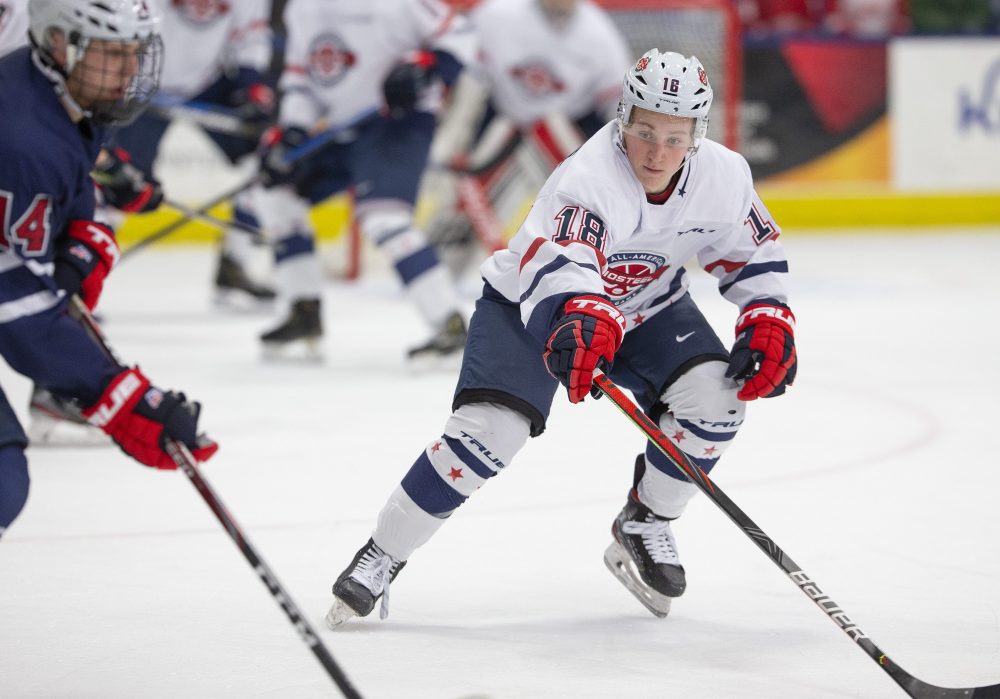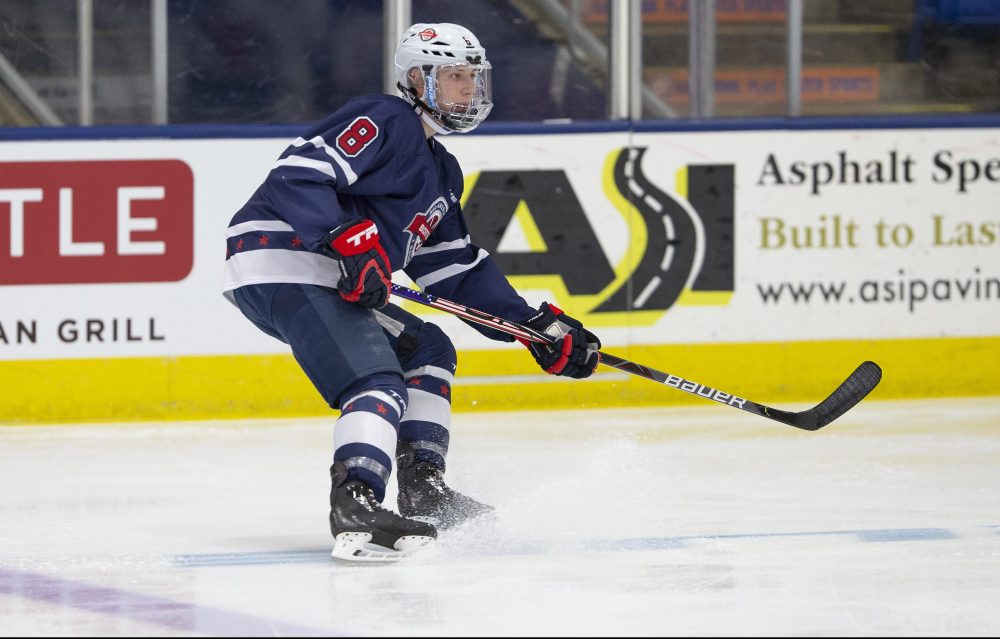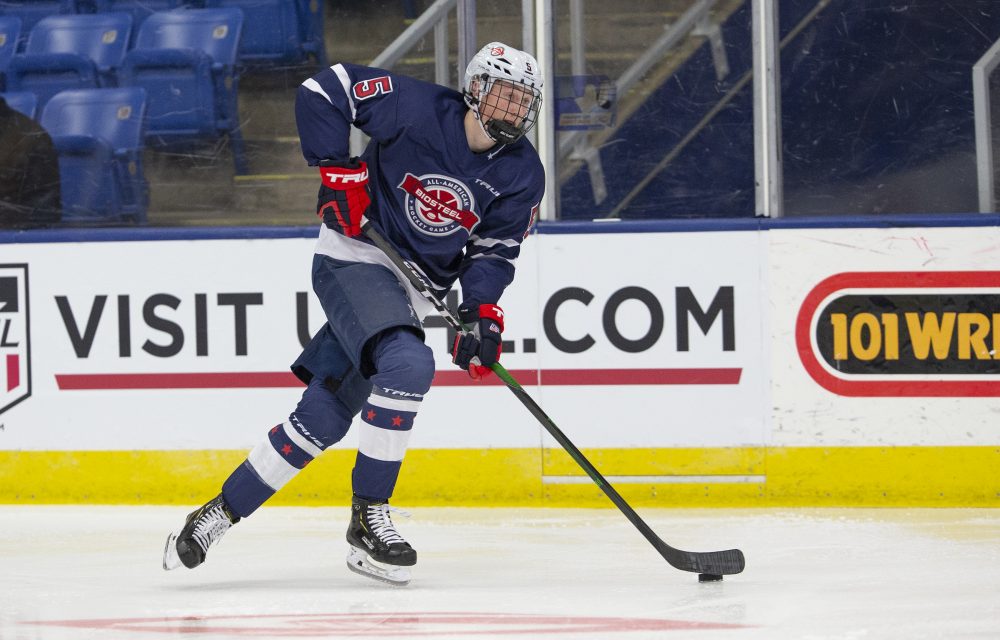Last year, in reviewing the 2019 USHL Top Prospects Game, I included the following graph, illustrating how many participants in the league’s prestige event are eventually drafted:
 The years 2012-2018 are pertinent here, as previously the event had different criteria for eligibility to participate for players. Between 2012-2019, the event was restricted to players who were eligible for the upcoming draft, and members of the USNTDP program were not a part of the festivities.
The years 2012-2018 are pertinent here, as previously the event had different criteria for eligibility to participate for players. Between 2012-2019, the event was restricted to players who were eligible for the upcoming draft, and members of the USNTDP program were not a part of the festivities.
Adding in the 2019 players to the above chart, now that we know who has been drafted, the numbers are now as follows:
Not Drafted: 164 (56.9%)
Drafted: 124 (43.1%)
Although slightly fewer than 50% of the game’s participants were drafted, it was a strong year for the league, as a number of other players who weren’t at the game, like Nick Abrusseze, or Ronnie Attard, were drafted even though they didn’t travel to Lincoln, Nebraska for the event.
That said, the 2019 Top Prospect game was the end of an era, as the league has taken a different approach to showcasing its best draft eligible talent, an approach that debuted two nights ago in Plymouth, at the home rink of the USNTDP. The event, now called the All-American game, is a blend of the USHL Top Prospect game of previous years, and the defunct preseason All-American game that would pit all American players in one free for all game, including USNTDP players, USHLers, high schoolers, and CHL talent.
This year (the future is TBD), the All-American game saw the USNTDP-U18 squad face off against an All-Star team of American USHL talent. So, players like Daniil Guschin (Russia), Colby Ambrosio (Canada), Travis Treloar (Sweden), Kristof Papp (Hungary), and Jakob Dobes (Czech Republic), who would have played at last year’s event, were not welcome this time around. Now even taking away a number of the more exciting draft prospects in the league, and the USHL not being, as a whole, as a strong with draft eligible as last year, the league is still abundant with talented young players.
Of course, even with the rules of the game, and with the inevitable injuries preventing some players from participating (Ben Meehan, Patrick Guzzo), I would personally have found a spot for Cameron Berg of Muskegon, Josh Groll of Lincoln, Sam Stange of Sioux City, and possibly Ben Schoen of Youngstown, although the latter has been limited to 13 games this season, and only recently returned from injury. On the blueline, I had fewer concerns, but it would have been good to see Christian Jimenez of Sioux City in the game.
Before you (rightly) point out that in adding a player, I would have to also remove one, I should point out that the USNTDP played with 13 forwards and seven blueliners, even with nominal top pairing defender Eamon Powell sitting out with a shoulder separation. Were the teams to be even, we could have added the extra defender and one extra forward without any cuts, and regarding the other three forwards, I’m not sure that either of Alex Gaffney (Muskegon) or Ryan Beck (Dubuque) - despite the assist for the former - are really among the best the league has to offer this year. I would also say the same about low scoring Nick Capone (Tri-City), but he at least adds a different dimension to the team with his energetic forechecking, and hell-on-wheels skating from a big frame.

Gunnarwolfe Fontaine 2020 All-American Game. Photo by Rena Laverty USNTDP
As far as the results of the game in question, though, the All-American team were always going to be at a disadvantage, no matter how optimal their roster. For one, the players had mostly been playing for their regular club teams as recently as two days prior to the game in question. With the notable exception of the American first line which was made up, whole hog, of the Chicago Steel first line consisting of Brendan Brisson between Gunnarwolfe Fontaine on the left and Sean Farrell on the right, the other lines had little to no familiarity with one another and very little practice with which to gain it.
Another disadvantage to the All-Star squad was that they were playing in the home rink of the USNTDP. The rink itself is nice enough by USHL standards, but the crowd, as with most audiences in my experiences in Plymouth, was made up more of scouts than of fans. Sure, a game like this brings out more family members than most games (and I do enjoy talking with parents). So, even if the USNTDP does receive the same type of home ice advantage as other league teams do, the advantage is still present and baked into the final result.
So that end result, seeing the USNTDP squad beat the USHL All Stars by a 6-1 final score was fully expected. At the same time, it flattered both teams. I will explain in more detail further on, but will point out here that the USHL goal, scored by Alex Laferriere was flukish, as the puck was redirected by a USNTDP defender into his own net. Were this an MLS game, it would have been marked down as an own goal. On the other hand, the USNTDP did not quite control the run of play or possession, but some of that was score effects (the losing squad ringing up the shot counter as the leading team collapses into a defensive game. The USHL All Stars had more than their share of shots in the second half, after they were already down by a bunch but all too many of their shots were perimeter jobs, and they rarely challenged the USNTDP netminders Noah Grannan or Drew Commesso.
Prior to the game, I heard a few reports of the All-American team coming in with heightened motivation, which made sense, beyond the standard motivated hockey player, in that many of the players had tried out for the USNTDP program a few years back, and with the exception of program graduates Ryder Rolston and Sean Farrell, were turned down for the players on the other side of the ice.
Some of that motivation could be seen in the first shift, as injury replacement Trevor Kuntar was flying, finishing a couple of big hits early, and getting the first shot on net. Then again, it didn’t take very long for the USNTDP to turn that momentum around, as big blueliner Tyler Kleven headmanned the puck to a streaking Brett Berard who skated in alone and easily slotted the puck past netminder Aidan McCarthy. The game was only 69 seconds old.
The game then went tame for a few minutes, a stretch highlighted by some fancy footwork from Farrell in the corner of the offensive zone, drawing a high sticking penalty. The USNTDP killed that penalty easily enough but took another shortly thereafter. Around halfway through the second power play opportunity, USHL winger Alex Laferriere, who had been showing nice pace throughout the first ten minutes, getting clean for a few breakaways, released a shot/pass from the left side to the far post, which was knocked into the USNTDP net by penalty killer Hunter Strand. The goal counted for Laferriere, but the most impressive parts of his game came on other shifts. In my earlier views of the Des Moines forward, he showed a fantastic shot, but his skating suffered due to an unfortunate crowhop at start up. Speaking to the player after the game, he noted that he had focused heavily on his skating all year and the effect was palpable. His stride and startup have both gone from marginally below average, to marginally above, with no detriment to the rest of his game.

Josh Sanderson 2020 All-American Game. Photo by Rena Laverty
The rest of the first period belonged entirely to the USNTDP. It took them 6.5 minutes to pop the twine again, and a young man who made a big impact on the game got the ball rolling as Jake Sanderson entered the offensive zone with dynamic speed, driving the net with intent. A mild scramble ensued, and Ty Smilanic banged the puck home. As recently as one week previous, Smilanic was not expected to be in the game, as he was in recovery from a broken finger sustained after receiving a wrist shot on the inside of his glove. The unfortunate forward had already missed stretches of the year due to mono and later a high ankle sprain, so the last thing he wanted to do was allow scouts to perceive of him as injury prone. The Quinnipiac commit plays a game based on speed and hustle and a broken digit can’t stop that.
Less than one minute after the Smilanic goal, with the USHL All Stars still believing that they could come back, those hopes were quashed. The USNTDP had an offensive zone faceoff. Thomas Bordeleau won the draw cleanly, and left winger Luke Tuch knocked the puck back to the left point, onto the stick of Owen Gallatin. In one touch, the latter pushed the puck to his right where big Tyler Kleven, who we last saw setting up Brett Berard on a breakaway, was already rearing his big stick backwards. In previous viewings, I had only seen Kleven demonstrate a “get it to the net” point shot, not something that would lead to many direct goals. This was different. Substantially different. He simply drilled it. It was in the back of the net in a blink. Kleven was ostensibly a stay-at-home blueline and here he was with two points in the first period that both were points of skill. I had previously spoken with an NHL scout who had Kleven in his first-round outlook and I had been dismissive. I spoke to Kleven after the game, and he mentioned wanting to be seen as a two-way defender. With that first period, he showed me more of what he could be, and I will be watching him more carefully going forward. That scout was not as off-base as I had thought.
Netminder Aidan McCarthy was in an odd position in this game. The Dubuque goalie has only played roughly one out of every three games for the Fighting Saints to reasonable, if unspectacular results. The defense in front of him here did not do much to prevent the USNTDP from generating high danger scoring chances and even though he gave up three goals on 19 shots through a touch over half the game, he made a few nice kick saves and showed solid athleticism. But he also showed why he is a part timer, with some poorly dropped rebounds and a lack of steadiness on his feet.

Tyler Kleven 2020 All-American Game. Photo by Rena Laverty, USNTDP
Meanwhile, as the second period got underway, Tyler Kleven continued to impress, this time on his own side of the puck, using positioning and stick work, along with his natural size to shut down plays on his side of the ice. The USHL All Stars had the best run of play in the middle period, even if it didn’t result in a goal. Tri City defender Mitch Miller was perhaps the most impressive player on the team. He was activating on ff the rush, showing plus skating, for its speed as well as for his stop-start ability and change of direction. He created a few exciting zone entries, even if nothing came of them in the end. Away from the puck, despite ending the game with a dash 4, Miller showed enough reach from his 5-10” frame to strip opponents of pucks along the boards. He lacks a significant physical game, but he may have enough hockey smarts to hold his own defensively even without the size component.
On the other side, Jake Sanderson showed the diversity in his game, besides dynamic skating, he could play a forceful physical game, knocking players to the ice with a strong shoulder at the end of a play. Speaking to him after the game, he noted that, in addition to working on his skating (his father Geoff, was one of the faster NHLers of the 1990s), he has been trying to grow into a leadership role on the team, getting physically stronger and refining his offensive skills.
With a touch over five minutes left in the second, the USNTDP scored the only goal of the frame, as Landon Slaggert entered the offensive zone with speed, handed the puck off to Thomas Bordeleau and raced to the slot to get the puck back. This time he took it to the net, where Luke Tuch stuffed it in.
Despite outshooting the USNTDP 10-5 in the period, the USHL All Stars never really threated to score, giving an easy time of it to program goalies Noah Grannan, and later Drew Commesso.
Once we got to the third, the USHL All-Stars had mostly stopped pushing, with most zone entries ending with shots from the perimeter, rarely inside of the faceoff circles. The USNTDP played a more relaxed game, with some of their nominally more defensive/responsible players showing off a touch of skill. Like Luke Tuch with a backhanded breakout pass early in the period. Or fellow big man Dylan Peterson with a slick behind-the-back play from the slot to the near side post. Jake Sanderson continued to impress, pushing the All Stars on their heels with speedy zone entries. One of those plays ended in his team’s fifth goal after he carried the puck in deep and then dished to the far post where Hunter Strand was able to tap it in past Logan Stein.
Even netminder Noah Grannan got in on the action, coming out of his crease to stare down a breakaway, leaving the skater with little room to aim for. For the most part, though, when the All-Star team established possession in the USNTDP end, the program skaters would play tight in the home plate area, keeping the All-Stars to the perimeter.
One last skill play came with 5.5 minutes left as USNTDP defenseman Jacob Truscott showed some wheels racing to win a loose puck, adjusting to a broken play and getting it on the net for one last goal.
Despite the lopsided 6-1 final score, I cannot say that any player on either side helped or hurt his chances come the draft in June. Some players may have made the advancements in their game more emphatic – Laferriere’s skating, Miller’s transition game, Sanderson’s everything, Kleven’s offensive impact – the players will still have to maintain their newly refined skillsets throughout the second half of the USHL season, and for the USNTDP, into the WU18 tournament before their names find homes in one NHL organization or another on draft day.